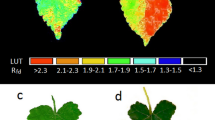Abstract
The response of tomato plants to various chilling treatments was studied using two approaches for the measurement of photosynthetic activity. One involved the use of a portable fluorometer for the measurement of in-vivo chlorophyll fluorescence, while the other employed a newly introduced photoacoustic system which allowed changes in oxygen evolution to be followed in a leaf disc. A strong correlation was found between results obtained by each system and those obtained by a conventional open gas-exchange system for the determination of CO2 uptake. Both systems of measurements could readily distinguish between the effects of chilling in the dark (at 3° C for 18 h) and chilling at high photon flux density (2000 μmol m-2 s-1 for 5h at 5° C). Chilling in the dark had practically no effect on the quantum yield of oxygen evolution, chlorophyll fluorescence or CO2 uptake, while chilling at excessively high photon flux density resulted in a sharp reduction (50–70%) in the quantum yields obtained. The results support the view that photosystem II cannot be the primary site of damage by chilling in the dark, although it is significantly affected by chilling at high light intensity.
Similar content being viewed by others
Abbreviations
- DCMU:
-
3-(3′,4′-dichlorophenyl)-1,1-dimethylurea
- PA:
-
photoacoustic
- PFD:
-
photon flux density
- PSII:
-
photosystem II
References
Badger, M.R., Collatz, G.J. (1977) Studies on kinetics mechanism of ribulose-1,5-biphosphate carboxylase and oxygenase reactions, with particular reference to the effect of temperature on kinetics parameters. Carnegie Instn. Yrbk. 76, 355–361
Baker, N.R., East, T.M., Long, S.P. (1983) Chilling damage to photosynthesis in young Zea mays. II. Photochemical function of thylakoids in-vivo. J. Exp. Bot. 34, 177–188
Berry, J., Björkman, O. (1980) Photosynthetic response and adaptation to temperature in higher plants. Annu. Rev. Plant Physiol. 34, 491–543
Bradbury, U., Baker, N.R. (1981) Analysis of the slow phases of the in-vivo chlorophyll fluorescence induction curve. Changes in the redox state of photosystem II electron acceptors and fluorescence emission from photosystem I and II. Biochim. Biophys. Acta 635, 542–551
Bravdo, B. (1971) Carbon dioxide compensation point of leaf and stem and their relation to net photosynthesis. Plant Physiol. 48, 607–612
Bults, G., Horowitz, B.A., Malkin, S., Cahen, D. (1982) Photoacoustic measurements of photosynthetic activities in whole leaves. Photochemistry and gas exchange. Biochim. Biophys. Acta 679, 452–465
Kanstad, S.O., Cahen, D., Malkin, S. (1983) Simultaneous detection of photosynthetic energy storage and oxygen evolution in leaves by photothermal radiometry radiometry and photoacoustics. Biochim. Biophys. Acta 722, 182–189
Krause, G.H., Weis, E. (1984) Chlorophyll fluorescence as a tool in plant physiology. II. Interpretation of fluorescence signals. Photosynth. Res. 5, 139–157
Lasser-Ross, N., Malkin, S., Cahen, D. (1980) Photoacoustic detection of photosynthetic activity in isolated broken chloroplasts. Biochim. Biophys. Acta 593, 330–341
Long, S.P., East, T.M., Baker, N.R. (1983) Chilling damage to photosynthesis in young Zea mays. I. Effect of light and temperature variation on photosynthetic CO2 assimilation. J. Exp. Bot. 34, 177–188
Malkin, S., Cahen, D. (1979) Photoacoustic spectroscopy and radiant energy conversion: Theory of the effect with special emphasis on photosynthesis. Photochem. Photobiol. 29, 803–813
Martin, B., Ort, D.R. (1982) Insensitivity of water oxidation and photosystem activity in tomato to chilling temperatures. Plant Physiol. 70, 689–694
Melcarek, P.K., Brown, G.N. (1977) The effect of chilling stress on the chloroplast fluorescence of leaves. Plant Cell Physiol. 18, 1099–1107
Melcarek, P.K., Cernohlavek, L. (1977) A solid state device for the simultaneous measurement of prompt and delayed chlorophyll fluorescence induction transients in leaves. Anal. Biochem. 82, 473–484
Murata, N. (1975) Temperature dependence of chlorophyll a fluorescence in relation to physical phase of membrane lipids in algae and higher plants. Plant Physiol. 56, 791–796
Öquist, G. (1983) Effect of low temperature on photosynthesis. Plant Cell Environ. 6, 281–300
Papageorgiou, F. (1975) Chlorophyll fluorescence: An intrinsic probe of photosynthesis. In: Bioenergetics of photosynthesis, pp. 319–371, Govinjee, ed. Academic Press, London New York
Patterson, B.D., Paull, R., Smillie, R.M. (1978) Chilling resistance in Lycopersicon hirsutum Humb. & Bonpl., a wild tomato with a wide altitudinal distribution. Aust. J. Plant Physiol. 5, 609–617
Poulet, P., Cahen, D., Malkin, S. (1983) Photoacoustic detection of photosynthetic oxygen evolution from leaves. Quantitative analysis by phase and amplitude measurements. Biochim. Biophys. Acta 724, 433–446
Powles, S.B., Björkman, O. (1982) Photoinhibition of photosynthesis: Effect on chlorophyll fluorescence at 77 K in intact leaves and in chloroplast membranes of Nerium oleander. Planta 156, 97–107
Powles, S.B., Berry, J.A., Björkman, O. (1983) Interaction between light and chilling temperature on the inhibition of photosynthesis in chilling sensitive plants. Plant Cell Environ. 6, 117–123
Schreiber, U., Groberman, U.L., Vidaver, W. (1975) Portable solid state fluorometer for the measurement of chlorophyll fluorescence induction in plants. Rev. Sci. Instrum. 46, 538–542
Smillie, R.M. (1979) The useful chloroplast: A new approach for investigating chilling stress in plants. In: Low temperature stress in crop plants. The role of the membrane, pp. 187–202. Lyons, J.M., Graham, D., Raison J.K., eds. Academic Press, London New York
Smillie, R.M., Hetherington, S.E. (1983) Stress tolerance and stress induced injury in crop plants measured by chlorophyll fluorescence in-vivo. Plant Physiol 72, 1043–1050
Somerville, S.C., Somerville, C.R. (1983) Effect of oxygen and carbon dioxide on photorespiratory flux determined from glycine accumulation in a mutant of Arabidopsis thaliana. J. Exp. Bot. 34, 415–424
Author information
Authors and Affiliations
Rights and permissions
About this article
Cite this article
Yakir, D., Rudich, J. & Bravdo, BA. Photoacoustic and fluorescence measurements of the chilling response and their relationship to carbon dioxide uptake in tomato plants. Planta 164, 345–353 (1985). https://doi.org/10.1007/BF00402945
Received:
Accepted:
Issue Date:
DOI: https://doi.org/10.1007/BF00402945




